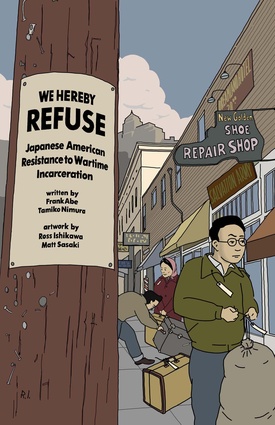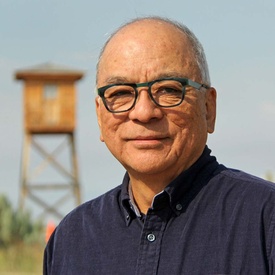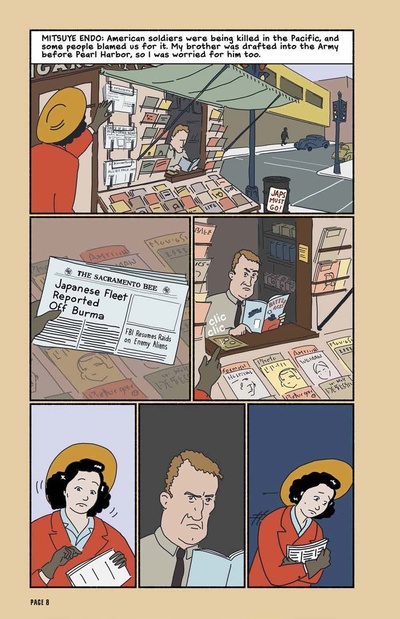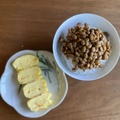“It’s the story of camp as you’ve never seen it before,” said Frank Abe, one of two authors of the upcoming graphic novel We Hereby Refuse: Japanese American Resistance to Wartime Incarceration.
“I hope readers see that there were several paths to resistance, and none of them were easy,” Tamiko Nimura, the second author of the novel commissioned by the Wing Luke Museum, commented in a recent interview.
Blended into over 150 pages of art by illustrators Ross Ishikawa and Matt Sasaki, We Hereby Refuse captures not only the wave of uncertainty that swept through the Japanese American incarceration camps during the second World War under Executive Order 9066, but also the remarkable surge of defiance that proliferated in response.
Following the lives of resisters Jim Akutsu, Hiroshi Kashiwagi, and Mitsuye Endo through both camp and court, the graphic novel catapults the reader into a not-so-distant past when the rights of Japanese Americans were heavily debated by their government. As they are categorized as IV-C (a Selective Service classification reserved for enemy aliens), separated from family, stripped of their jobs and homes, and tossed from camp to camp, each incarceree is left with an important decision to make:
To remain silent, or to stand up and fight.
With a background in American ethnic studies and a personal connection to wartime resistance, Tamiko Nimura pours in decades-worth of research alongside Frank Abe, writer and director of PBS’ Conscience and the Constitution and co-editor of JOHN OKADA: The Life & Rediscovered Work of the Author of No-No Boy.
Enticed by the dynamics of three Japanese Americans with three very different backgrounds, Abe and Nimura convey the true weight of defiance—victories and ramifications included.
“Even though I knew a fair amount of camp history already, I was surprised to see just how widespread resistance was, how many different forms it took, and how much it had been hidden, ignored and stigmatized,” said Nimura.
Authors Abe and Nimura also ensure that the resisters who took a stand against the only country they have called home are cast in a new light, redefining the so-called “passive” Japanese American incarceree narrative.
“Each of our three central characters presented a fresh opportunity,” Abe voiced, “The chance to turn the story of John Okada’s No-No Boy inside out, the possibility to finally solve for myself the problem of how to reframe the story of Tule Lake, and the unexpected prospect of creating Mitsuye Endo as a fully rounded character.”
And doing just that, the team behind We Hereby Refuse gifts audiences with the seldom-heard stories of Japanese American resistance through a dramatic unification of art and history.
Jim Akutsu, whose story opens the novel, serves as a figurehead for Washington resisters—a nod to the Wing Luke Museum’s location in Seattle according to Nimura. Akutsu, who initially was willing to serve but later refused to be drafted following the fickle restoration of his citizenship, would later become a speaker at the 1981 Commission on Wartime Relocation and Internment of Civilians in Seattle and the inspiration behind John Okada’s fictional novel, No-No Boy.
“We even give Okada a cameo appearance,” Abe mused.
Another particularly important task for the authors was the reframing of the Tule Lake internment camp through Hiroshi Kashiwagi.
An internment camp-turned-segregation center for those who refused to answer the government’s loyalty questionnaire, Tule Lake was largely considered the black sheep of the camps among internees. Renouncing citizenship was not uncommon as wartime frustrations dragged on and pressure from the government mounted.
“Correcting all the lies and distortions around Tule Lake—that contesting community leadership and government duress equated betrayal of country and the Constitution—was kind of the final frontier for documenting camp resistance,” Abe further voiced.
Although Hiroshi Kashiwagi’s own resistance to the prying, accusatory loyalty questions issued by the U.S is a reflection of the “contesting community leadership” and “government duress” that circulated at Tule Lake, he became an outspoken author and advocate well beyond his time in camp. Kashiwagi later earned the American Book Award for his memoir Swimming in the American. As his niece, Nimura’s work while editing his first book inspired her to learn more about camp resistance.
But, while both Akutsu and Kashiwagi were visible and vocal to the public long after their incarceration, the last of the book’s three highlighted subjects—Mitsuye Endo—was not.
Endo, with the exception of two interviews with John Tateishi and Cal State Fullerton, remained largely hidden from the public eye following the success of her wrongful termination contestment turned Supreme Court habeas corpus case.
As a result, Endo’s character was the trickiest to maneuver.
“We had a sense of Endo’s actions, but since she was the only one of our characters I’d never met in person, the challenge was how to write dialogue for her that didn’t sound forced,” said Abe.
However, despite the “parts of her story that seemed lesser-known and deserved much more attention,” according to Nimura, the authors were willing to put in the research needed to represent the “only female Nikkei plaintiff whose wartime case was heard by the U.S. Supreme Court.”
With input from a few connections, including Endo’s son and the daughter of Endo’s attorney, the novel was able to pull together all of the strands, as Abe puts it, needed to faithfully capture the arc of Endo’s story from start to finish.
From the barracks to the Supreme Court, the authors and artists of We Hereby Refuse deconstruct the stories of three Japanese Americans who saw a cause worth fighting for—even in the face of adversity.
“Our ideas about ‘resisters’ have hardened into stereotypes or statues,” Nimura points out. “This book shows that these were human beings making complex decisions.”
And, as Abe stresses:
“I hope readers come away agreeing with the tagline, that this is the story of camp as you’ve never seen it before. The book squarely addresses race as the only characteristic common to the 120,000 people locked up in WW2, and race is still dividing us today. The same elements of fear and ignorance of the ‘other’ that open the book are present today. The takeaway is that some things haven’t changed. And if you see in our storytelling the mechanics of how mass exclusion and incarceration was executed and enforced once before, it can prepare you to see the warning signs we certainly saw over the last four years, and how to contest them.”
* * * * *
Join authors Frank Abe and Tamiko Nimura and artist Ross Ishikawa for a conversation moderated by UCLA professor Dr. Kelly Fong on Saturday, June 26 from 2 p.m. to 3:30 p.m. (PDT). A meet-and-greet for JANM members only is additionally scheduled for 1 p.m. We Hereby Refuse is available for purchase at the JANM Store.
©2021 Kyra Karatsu










